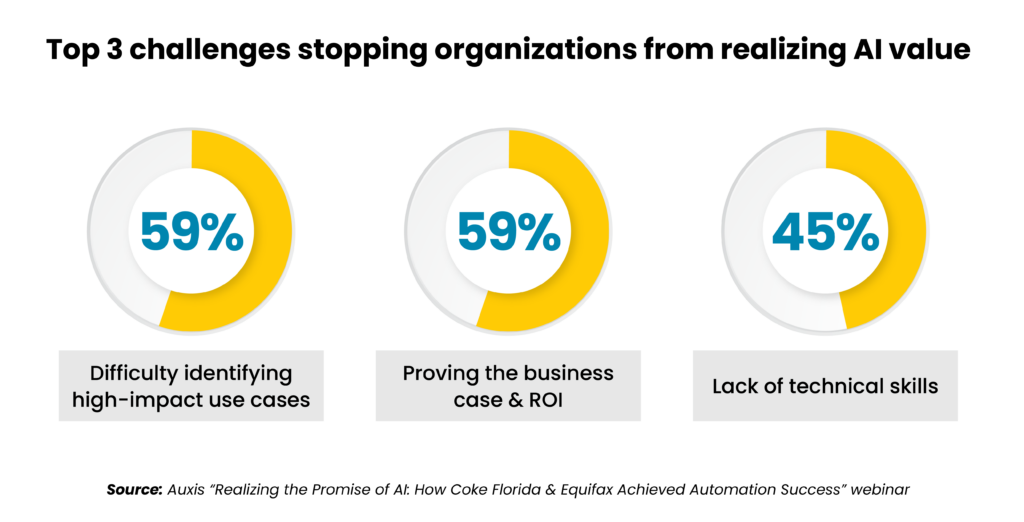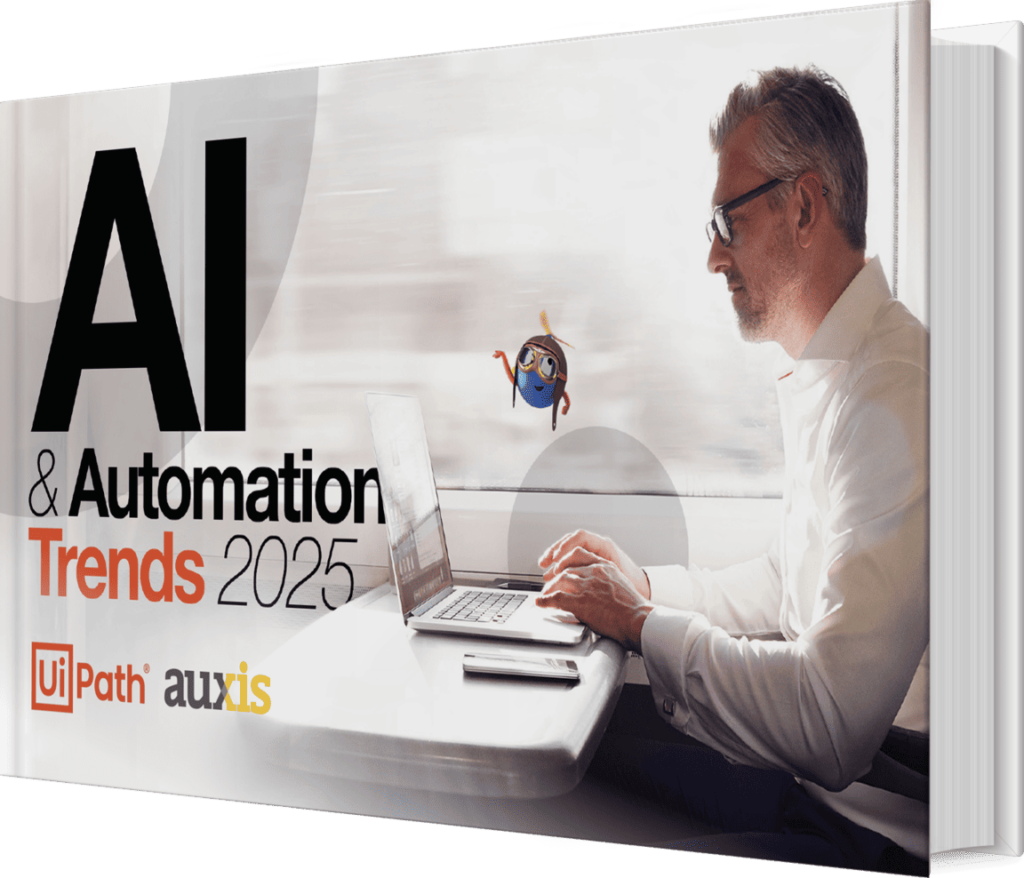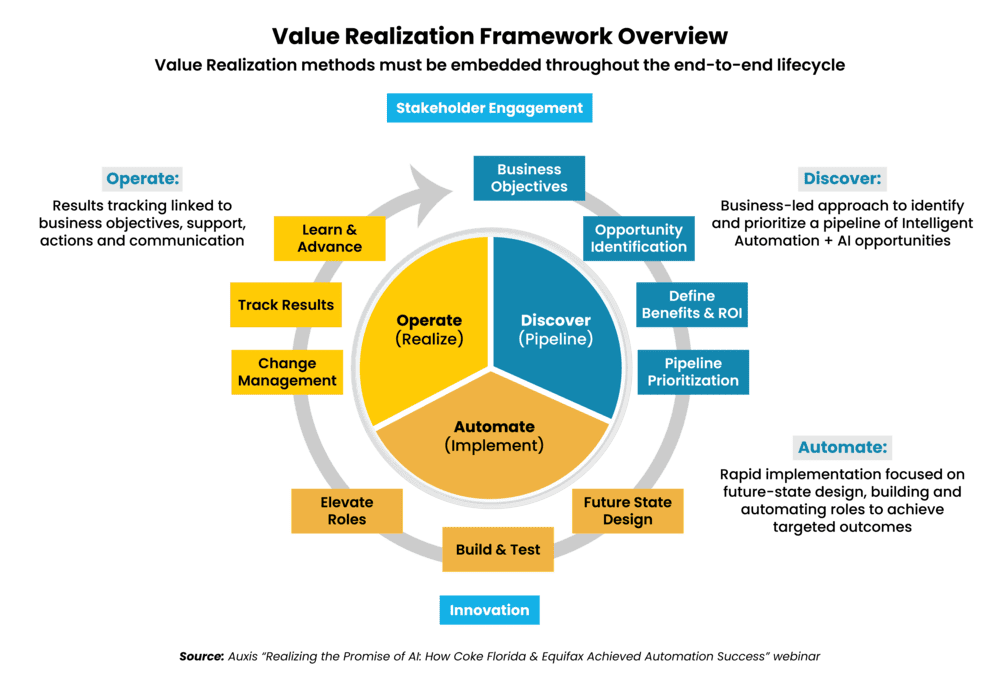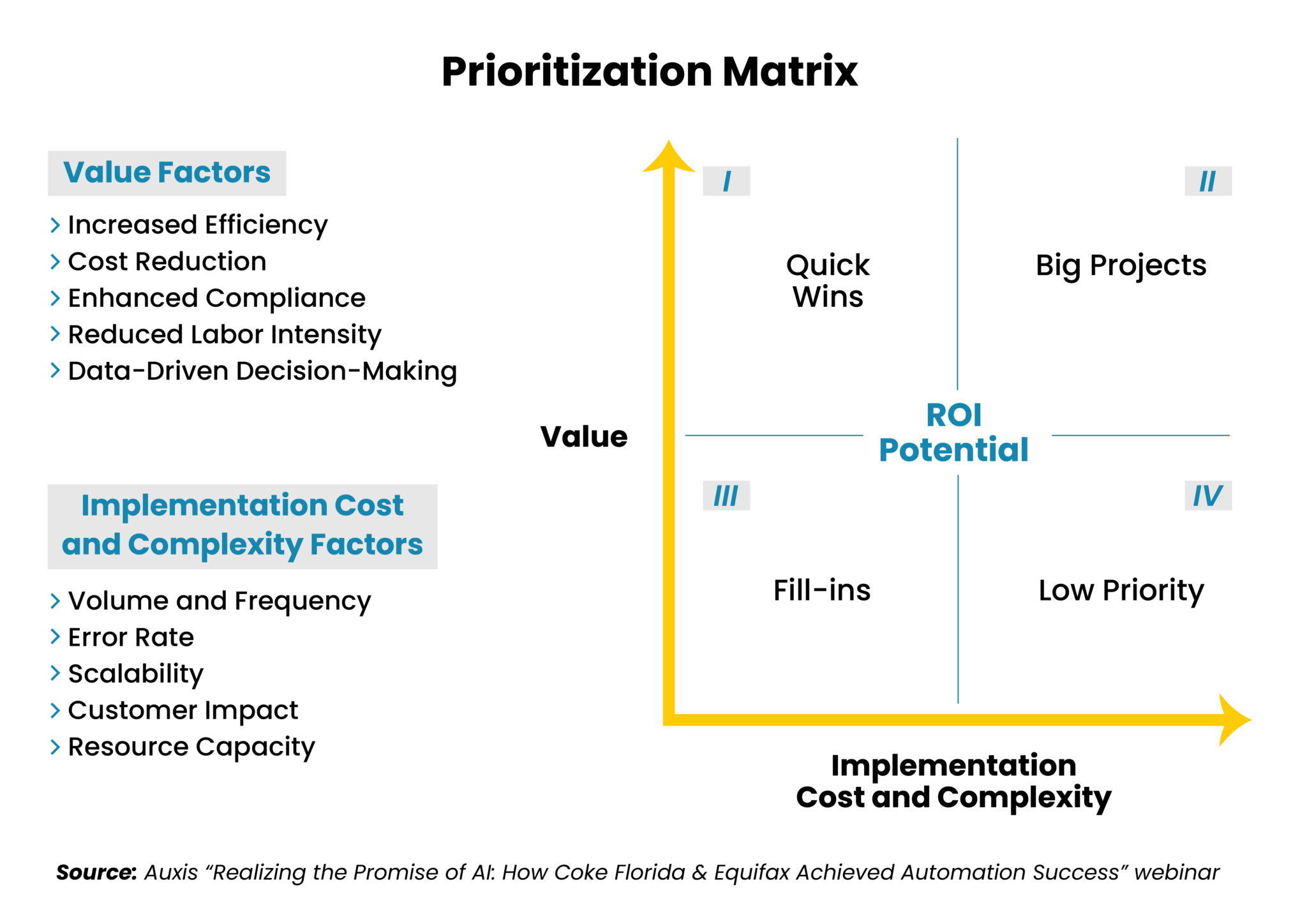In brief:
- 75% of companies rank AI investment as a top priority, but only 25% are achieving significant value.
- The main challenges to AI value creation include proving the ROI and business case for AI, identifying high-impact use cases, and a lack of necessary technical skills.
- A well-structured value realization framework drives a successful AI program, providing an overarching business strategy for evaluating opportunities, measuring impact, and scaling initiatives effectively.
- Following 8 best practices sets you on the road to sustainable AI success.
Considered the most transformational technology since the internet, more and more companies are investing in artificial intelligence (AI) with expectations of improved processes, lower costs, and new revenue streams. Yet, while emerging innovations such as Generative AI and Agentic AI capture enterprise interest, the targeted AI ROI from these investments has been slow to materialize.
Three-quarters of companies rank AI as a top investment priority, but only 25% are seeing significant value, BCG’s 2025 Closing the AI Impact Gap report found. Just 1% of companies believe their organizations are “mature” on the AI deployment spectrum, meaning AI is fully integrated into workflows and driving substantial business outcomes, states McKinsey’s 2025 Superagency in the Workplace report.
This blog explores the main challenges that stop organizations from realizing the promise of AI — and offers practical strategies for creating an Intelligent Automation program that delivers.
3 biggest challenges to AI value realization
While AI adoption and implementation journeys differ widely, business leaders cited three challenges as the biggest barriers to scaling their intelligent automation programs during a recent Auxis webinar, “Realizing the Promise of AI: How Coke Florida & Equifax Achieved Automation Success.” Bringing together more than 100 AI experts and enterprise leaders, the webinar explored real-world success stories and strategies for turning the promise of AI and automation into reality.

1. Identifying high-impact AI use cases
Identifying the right use cases is the biggest challenge organizations face in their AI journey, as confirmed by 59% of webinar attendees. Most businesses lack a clear framework for assessing which processes will deliver the greatest returns, focusing on isolated, low-value tasks instead of broader, transformational opportunities that align with strategic goals.
This, in turn, makes it difficult to determine where AI can drive measurable efficiency and ROI.
Major challenges typically include data readiness and process complexity. Many businesses lack visibility into inefficiencies that AI can optimize due to a lack of clean, structured data and well-defined processes. Data quality issues ranked as the biggest concern for gaining business value from Generative AI (GenAI) on the 2025 Agentic AI Report presented by UiPath and Auxis.
There’s also often a disconnect between IT and business leaders, with automation seen as a technology-driven initiative rather than a business transformation tool. Without cross-functional collaboration and stakeholder engagement, organizations miss opportunities to automate high-value processes.
McKinsey’s report asserts that the biggest barrier to scaling AI is business leaders who are not steering fast enough.

2. Proving the ROI and business case for AI
Often stemming from an inability to identify high-impact use cases, failing to prove ROI can be the quickest way to derail AI value. Webinar attendees deemed proving a solid business case an equally tough challenge for getting AI initiatives off the ground.
As organizations advance beyond implementing initial AI quick wins or a Proof of Concept, pressure mounts to generate ROI sustainably and keep the pipeline of opportunities flowing. But C-suite executives report limited returns on enterprise-wide AI investments: only 19% say revenues have increased more than 5%, McKinsey found.
Without significant ROI coming in, it becomes difficult to make a business case for adding resources and budget to your program – hampering your ability to maximize AI potential.
A strong business case for AI requires clear success metrics, well-defined use cases, and alignment with strategic goals instead of siloed implementations to ensure tangible AI value creation. Yet, 60% of companies fail to define and monitor any KPIs related to AI and value creation, BCG found.
Consequently, organizations find themselves stuck in a cycle of failing to measure success and justify investments for scaling.
3. Lack of technical skills
With a talent war brewing for AI – and particularly GenAI – skills, many organizations are already facing skill shortages, hiring challenges, and escalating costs for top AI talent. Half of the highest-paid IT skills today are related to AI and machine learning, with GenAI taking the top spot, Motion Recruitment’s 2025 tech salary report found.
Already, the lack of technical skills is taking a toll on AI initiatives – four in five AI projects are failing due to lack of internal knowledge and preparation, Pluralsight’s 2025 Tech Forecast found. Nearly half (45%) of webinar attendants ranked lack of technical skills as their biggest barrier to success.
Other common challenges organizations confront as they progress on their AI and automation journeys include keeping the automation pipeline flowing and evolving automation opportunities from low-hanging fruit to more advanced use cases. At the Auxis webinar, Jerome M. Austin, Coca-Cola Beverages Florida Intelligent Automation Lead, explained how his organization is reaching the next stage of AI-powered automation.
“We’re starting to leverage some of the technology that’s out there that didn’t exist several years ago: communications mining, some of the Generative AI capabilities, document understanding,” Austin said. “We’re starting to focus more on not just delivering a large volume of automations but really focusing on the value and types of automations we’re able to bring to life.”
8 best practices for AI value realization
Lack of a structured framework is a key reason many AI programs fail to achieve expected results – missing the overarching strategy that’s key to evaluating opportunities, measuring impact, and scaling initiatives effectively.
An effective value realization framework identifies the key phases of an AI and automation program, detailing the critical elements for each phase to achieve success:

Based on the Auxis AI Value Realization Framework presented at the webinar, here are eight best practices organizations can implement to achieve AI and process automation ROI, sustainably and at scale.
1. Start with an end goal in mind
Many organizations identify an end goal for their AI programs but fail to make sure it flows throughout the full implementation lifecycle.
In the rush to adopt AI, excited stakeholders often implement in silos instead of taking time to plan strategic initiatives aligned to business goals. Defining an end goal helps ensure AI initiatives match business priorities and are not just “nice to haves.”
Strategic planning also helps organizations prioritize problems that AI can realistically address, such as improving operational efficiency, enhancing customer experience, and making better data-driven decisions. Without clearly defined goals, enterprises risk investing in solutions that can’t scale or deliver significant business value, leading to poor adoption and missed opportunities for real transformation.
2. Take a business-led approach to AI transformation
With daily experience in the process weeds, business teams know what stands in the way of operational excellence. Successful transformation relies on business insights to design a better way of work – ensuring AI is deployed strategically, appropriately, and most effectively.
Without clear business alignment, AI projects risk becoming siloed, failing to generate meaningful ROI, or remaining stuck in pilot phases. A business-first mindset further helps in securing stakeholder buy-in, prioritizing resources, and ensuring change doesn’t cause related processes to break.
3. Maintain a continuous opportunity pipeline
In the Auxis webinar, Diquez called out pipeline management as “one of those things that a lot of organizations overestimate their ability to effectively manage, maintain, and drive.” To prevent the momentum of AI initiatives from stalling, pipeline discovery should be viewed as a loop, not a linear progression.
Establish a streamlined process for creating a continuous funnel of idea submission and vetting – performing a deep dive assessment of possibilities at frequent intervals to maintain a healthy backlog of approved automation opportunities. Meeting regularly with business stakeholders to identify emerging issues and opportunities is key.
Coca-Cola Florida’s Austin explained how the ability to recognize and respond to changing business priorities was key to value realization. “A lot of our early automation activity and prioritization was based on removing redundancy and repetitive tasks, but we’ve evolved our thinking.
“As a business, we’ve grown drastically both organically and through acquisition over the last several years. And so, one of the things we’ve tried to address through automation is how we can continue to scale our business and not add headcount. That’s been a real game-changer for us and I would say that’s probably the biggest shift in thinking around our overall pipeline management.”
UiPath Automation Hub, offered by the market-leading intelligent automation platform, represents Auxis’ choice for an effective pipeline management tool, efficiently managing automation opportunities with ongoing calculation of KPIs and value realization.
4. Prioritize opportunities based on value, cost, and complexity
Now that your pipeline is flowing, how do you evaluate every idea for feasibility, business impact, and alignment with strategic objectives? Using unique criteria to assess every opportunity can prove counterproductive for scalability, impacting your ability to compare initiatives with objectivity.
Building a Prioritization Matrix empowers data-driven decisions. It helps you select the most impactful AI and automation opportunities based on factors deemed important to your business such as benefits potential, criticality to business operations, complexity and risk, compliance assurance, and change readiness.
Assessing these factors ensures every project achieves efficiency, cost savings, and business objectives. Below is an example of an effective Prioritization Matrix that Auxis created for a customer:

5. Align with stakeholders
Like any enterprise-wide initiative, AI programs require stakeholder alignment and change management for success. Without buy-in from key stakeholders – including executives, department heads, and end-users – your projects risk resistance, insufficient resources, or misalignment with real business needs.
Remember the McKinsey finding about leaders not steering fast enough being the biggest barrier to scaling AI?
So, what can you do to turn your organization’s skeptics into AI champions?
- Demonstrate the “art of the possible”
Building awareness around the benefits of AI and automation is key to securing stakeholder support, offering an unfiltered view of how automation can improve outcomes and their daily work lives. Explained Austin in the Auxis webinar: “Stakeholders are focused on driving their day-to-day activities and whatever’s important for their responsibilities or jobs. Really getting their head around what’s possible, what’s doable, and how does this translate into what I do day in and day out — that’s the real key for engagement.” - Connect the dots
Communicate early and often the expected impact of a specific AI and automation project to everyone from enterprise leaders to the staff performing the work, with plenty of opportunities for aligning expectations and addressing concerns. Explained Austin: “For Coke Florida, automation isn’t really a way to take down headcount, even though there are a lot of repetitive tasks we’re eliminating. What we tried to educate our stakeholders on is how this gives us an opportunity to reallocate our time, our resources, and our energy towards more value-added activities — really doing more analytics and focusing on our overall customer experience.” - Say what you’ll do – and then do what you say
Execute automation programs with precision and in a timely manner to keep support from waning. Quick and early wins are key to generating enthusiasm that encourages stakeholders to champion your program across the enterprise. - Prioritize change management
Consider employee adoption in every aspect of program design. Identify the potential for elevated roles after AI-powered automation is implemented, enabling staff to focus on valuable, strategic, and fulfilling work that is more appropriate to their pay scales and skill sets. Prioritize adequate training and ongoing support to ensure your human and digital workforce work seamlessly together.
6. Measure value realization
How to measure AI performance is one of the biggest challenges organizations face. Continuously quantifying value is integral to maintaining organizational support, tracking and managing results to achieve targeted business outcomes.
At Auxis, we recommend integrating UiPath’s Automation Hub with its Insights tool to measure results in real time. Capturing actionable insights and creating customizable, interactive dashboards for monitoring KPIs and metrics enables you to quickly make corrections, prove value, and maximize returns.
Tailored reporting further conveys automation performance while historical data analysis helps identify automation patterns and trends. This also helps determine when business owners are not executing based on their new automation capabilities and offer appropriate guidance.
7. Don’t wait for things to break to create a support structure
Often the most overlooked and underinvested part of AI and automation programs, building an effective strategy for maintenance and support is essential to long-term success. This is especially important when organizations start to scale with multiple opportunities in the pipeline.
Robots are never a “set it and forget it” investment – inevitable process exceptions like a new website interface or invoice field can cause automation to break. Without an experienced automation team providing proactive support, promised outcomes can be difficult to achieve – causing enterprise enthusiasm to decline.
“Don’t get to the point where things are breaking for you to start thinking about these issues,” Auxis’ Diquez cautioned. “It’s one of the reasons we see organizations that were doing incredibly well crumble and stifle growth within their programs.”
8. Be ready to pivot
“We are living in very interesting times right now, and it’s moving fast,” Bill Woodford, Auxis Senior Managing Director of Digital Transformation, told enterprise leaders gathered for the webinar. “When we look at the amazing growth of AI and the amount of investment that’s going into it, the possibilities in front of us are truly exciting. Business leaders are not necessarily current on all the opportunities, so it’s incumbent on us to make sure they’re aware of the need for revised business goals and whole new business models.”
Investment in Agentic AI jumped from $0 in 2023 to $400 million in 2024 as organizations realize the ability to transform complex business processes that were previously beyond the reach of automation due to agentic’s unprecedented ability to act independently, adapt to changes, and make informed decisions.
To maximize value, business leaders need the flexibility to embrace rapid change. They also need to think about how emerging technology can elevate the roles of human staff — designing a future-state process matrix that details how AI and automation can work together by enabling people to focus on exceptions and higher-value tasks.
Why Auxis: A world leader in AI and automation implementation
For most organizations, turning AI vision into reality — and achieving meaningful ROI — requires an experienced AI implementation partner.
“When you do automation right, it becomes a strategic driver to the enterprise. We’ve seen from our leadership that every time they need to approach a new problem, it’s now like, ‘Okay, can we go automation first?’” Daniel Fernandez, Equifax RPA/AI Strategy & Product Leader, said in the Auxis webinar. “But while we do things in-house, we don’t have unlimited resources, and Auxis has helped us deliver that value. Keeping good partners is key to meeting pipeline expectations and knowing your program is adding value not only at a low level, but also at a high level to the overall vision of the company.”
Recognized as a Platinum Partner and Americas Partner of the Year by the leader in AI and automation, UiPath, Auxis brings the knowledge, talent, and experience to help you capture the enormous potential of AI and drive innovation and real business value across your enterprise.
Want to learn more about how Auxis can help you realize value from your AI and automation program? Schedule a consultation with our intelligent automation experts today! Or, visit our resource center for AI and automation tips, strategies, and success stories.
Frequently Asked Questions
What are the most common reasons AI projects fail to deliver expected value?
+AI projects often fail to deliver expected value due to unclear objectives, lack of alignment with business goals, and poor data quality. Another common issue is insufficient stakeholder engagement and support, which leads to poor adoption and integration. Additionally, many organizations struggle with scaling AI beyond pilot projects, failing to integrate it into core business operations. A lack of measurable KPIs and performance tracking can also prevent companies from recognizing when adjustments are needed to realize full value.
What metrics should organizations track to measure AI success?
+To measure AI success, organizations should track overarching metrics like return on investment (ROI), operational efficiency improvements, and cost savings. Key performance indicators (KPIs) such as process cycle time reduction, error rates, and customer satisfaction scores are also important. Tracking AI’s impact on revenue growth and decision-making speed can also help assess its effectiveness. Companies should also measure adoption rates and user satisfaction to ensure AI systems are successfully integrated into daily operations.
How can organizations prevent AI initiatives from stalling after initial deployment?
+To prevent AI initiatives from stalling, organizations must ensure continuous alignment with business goals and monitor performance regularly. It’s important to establish a clear roadmap for scaling AI solutions and securing ongoing stakeholder engagement. Regularly reviewing and adjusting AI models based on data feedback and evolving needs is crucial for sustained success. Organizations also need to invest in training and support to facilitate adoption and ensure AI is integrated across departments.
What are the key financial and operational benefits of AI-driven automation?
+AI-driven automation offers significant financial benefits, such as cost reductions through improved efficiency and minimized human error. It enhances process speed, accuracy, and consistency, which leads to faster decision-making and better customer experiences. AI automation also frees up human resources from repetitive tasks, enabling them to focus on higher-value work. Over time, these improvements lead to increased profitability, scalability, and a competitive edge in the market.
How do you build a strong business case for implementing automation and AI?
+Building a strong business case for automation and AI begins by clearly defining the problem to be solved and aligning it with strategic business goals. Organizations should identify key performance indicators (KPIs) that will demonstrate measurable value, such as cost savings, efficiency gains, and increased revenue. A detailed cost-benefit analysis, including ROI projections and timelines, helps justify the initial investment. Finally, securing stakeholder buy-in and ensuring that the initiatives are scalable and sustainable will strengthen the business case for AI and encourage long-term success.
How can organizations realize the full value of their AI investments?
+Organizations need a qualified and experienced AI implementation partner to ensure successful AI adoption and maximize returns on investment. An expert partner can help align AI initiatives with business objectives, identifying high-impact use cases, and integrating AI seamlessly into existing core business processes. They also provide valuable insights on best practices for scaling AI solutions and managing risks. Without the right expertise, organizations may face challenges in navigating the complexities of AI technology, leading to underperformance or failure to achieve desired results. Schedule a consultation today with our AI experts to see how we can help maximize returns from your AI investments.



